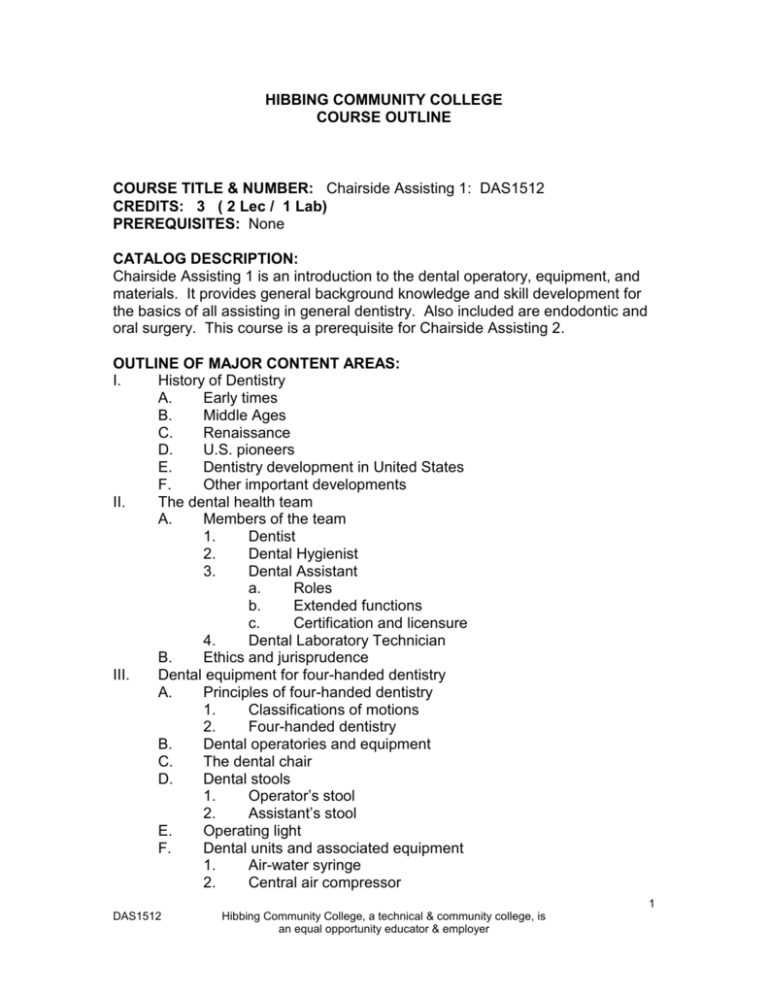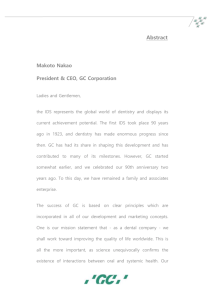DAS 1512 - Hibbing Community College
advertisement

HIBBING COMMUNITY COLLEGE COURSE OUTLINE COURSE TITLE & NUMBER: Chairside Assisting 1: DAS1512 CREDITS: 3 ( 2 Lec / 1 Lab) PREREQUISITES: None CATALOG DESCRIPTION: Chairside Assisting 1 is an introduction to the dental operatory, equipment, and materials. It provides general background knowledge and skill development for the basics of all assisting in general dentistry. Also included are endodontic and oral surgery. This course is a prerequisite for Chairside Assisting 2. OUTLINE OF MAJOR CONTENT AREAS: I. History of Dentistry A. Early times B. Middle Ages C. Renaissance D. U.S. pioneers E. Dentistry development in United States F. Other important developments II. The dental health team A. Members of the team 1. Dentist 2. Dental Hygienist 3. Dental Assistant a. Roles b. Extended functions c. Certification and licensure 4. Dental Laboratory Technician B. Ethics and jurisprudence III. Dental equipment for four-handed dentistry A. Principles of four-handed dentistry 1. Classifications of motions 2. Four-handed dentistry B. Dental operatories and equipment C. The dental chair D. Dental stools 1. Operator’s stool 2. Assistant’s stool E. Operating light F. Dental units and associated equipment 1. Air-water syringe 2. Central air compressor 1 DAS1512 Hibbing Community College, a technical & community college, is an equal opportunity educator & employer 3. IV. Oral evacuation systems a. Saliva ejector b. High-volume evacuator c. Central vacuum compressor Instrument transfer and oral evacuation A. Operating zones 1. The clock concept a. Static zone b. Assistant’s zone c. Transfer zone d. Operator’s zone e. Direct and indirect vision 2. Positioning the dental team and the patient B. Oral evacuation 1. HVE tip and handle 2. HVE tip placement a. Maxillary right quadrant b. Maxillary left quadrant c. Mandibular right quadrant d. Mandibular left quadrant e. Maxillary anterior teeth 1. Facial approach preparation 2. Palatal approach preparation f. Mandibular anterior teeth 1. Lingual approach preparation 2. Facial approach preparation 2. Saliva ejector C. Tongue and cheek retraction D. Instrument exchange 1. Instrument grasps a. Pen grasp b. Inverted or reverse pen grasp c. Palm grasp d. Palm-thumb grasp 2. The position of use 3. The fulcrum E. Basic principles of instrument exchange: steps F. Exchange of dental materials G. Preparation and transfer of handpieces H. Daily maintenance routine 1. Morning routine 2. Between-patients routine 3. Evening routine I. The patient visit 1. Preparation of the operatory 2. Admission of the patient 2 DAS1512 Hibbing Community College, a technical & community college, is an equal opportunity educator & employer V. 3. Seating the patient 4. Dismissal of the patient Dental instruments A. Hand-cutting instruments 1. Design a. Handle b. Shank c. Blade 2. Identification of instruments a. Black’s Basic Three-Number Formula b. Black’s Four-Number Formula B. Types of hand-cutting instruments 1. Discoid-cleoid 2. Spoon excavators 3. Chisels 4. Hoes 5. Hatchets 6. Gingival margin trimmers 7. Angle formers C. The basic setup 1. Mouth mirrors 2. Explorers 3. Cotton pliers D. Additional hand instruments 1. Spatulas 2. Plastic instruments 3. Condensers 4. Burnishers 5. Carvers 6. Periodontal probes 7. Files 8. Amalgam carriers 9. Matrix E. Rotary cutting instruments 1. Functions 2. Parts of the bur 3. Latch-type and friction-type burs 4. Carbide burs 5. Shapes of bur heads a. Round b. Inverted cone c. Straight fissure d. Tapered fissure e. End-cutting fissure f. Wheel g. Pear 3 DAS1512 Hibbing Community College, a technical & community college, is an equal opportunity educator & employer VI. 6. Surgical burs 7. Drills for pin retention F. Diamond rotary instruments G. Other rotary instruments 1. Mandrels 2. Discs 3. Points and stones Dental materials A. Dental amalgam 1. Advantages 2. Disadvantages 3. Mercury a. Silver b. Tin c. Copper d. Zinc 4. Forms of dental amalgam alloys 5. Mercury/alloy ratios 6. Trituration 7. Setting reactions B. Composite restorative materials 1. Types of polymerization a. Self-cured composites b. Light-cured composites 2. Forms of composites a. Macrofilled b. Microfilled c. Hybrid 3. Acid etch technique a. Enamel bonding b. Dentin bonding C. Dental cements 1. Zinc phosphate cements 2. Zinc oxide-eugenol (ZOE) cement 3. EBA cement 4. Ploycarboxylate cement 5. Glass ionomer 6. Resin D. Cavity liners E. Cavity varnishes: dentin sealants F. Local anesthetics 1. Chemistry and composition 2. Modes of action 3. Vasoconstrictors 4. Cautions for use a. Hazards for heart patients 4 DAS1512 Hibbing Community College, a technical & community college, is an equal opportunity educator & employer VII. b. Administration into a blood vessel c. Infected areas d. Temporary numbness e. Localized toxic reactions f. Systemic toxic reactions G. Topical anesthetics 1. Liquid topical anesthetics 2. Ointment topical anesthetics 3. Maxillary and mandibular anesthesia 4. Block anesthesia 5. Infiltration anesthesia 6. Periodontal ligament injection 7. Intraosseous anesthesia 8. The anesthetic syringe a. Thumb ring b. Harpoon c. Piston rod d. Barrel of the syringe e. Threaded tip 9. Disposable needle a. Lumen b. Cartridge end of the needle c. Needle hub d. Needle length e. Needle gage 10. Anesthetic cartridges a. Precautions b. Disinfecting cartridges 11. Administration of local anesthetics a. Instrumentation b. Application of topical anesthetic c. Preparing the anesthetic syringe d. Passing the syringe e. Care of the used syringe f. Care of needlestick injury Operative dentistry A. Principles of cavity preparation: terminology 1. Cavity walls 2. Line angle 3. Point angle 4. Bevels B. Types and uses of dental cement 1. Zinc phosphate cement a. Indications for use b. Instrumentation c. Manipulation for cementation 5 DAS1512 Hibbing Community College, a technical & community college, is an equal opportunity educator & employer 2. 3. 4. 5. 1. Procedure 2. Cementation of a crown 3. Removal of excess cement d. Manipulation for an insulating base: placement procedure e. Care of the slab and spatula Zinc oxide-eugenol cement a. Indications for use b. Contraindications c. Instrumentation d. Manipulation and placement as a sedative base e. Manipulation for cementation of temporary coverage f. Care of ZOE, pad, and spatula Polycarboxylate (polyacrylate) cement a. Instrumentation b. Manipulation and placement Glass ionomer cement a. Instrumentation b. Manipulation and placement Calcium hydroxide cavity liner a. Instrumentation b. Manipulation c. Placement 6. C. D. E. Cavity varnish a. Instrumentation b. Manipulation and placement Anterior (Class IV) composite restorations: instrumentation 1. Tooth preparation 2. Manipulation and placement 3. Finishing and polishing 4.. Procedure a. Cavity preparation b. Cavity liner c. Acid etching d. Bonding agent e. Composite placement f. Finishing the restoration 5. Optional placement method: crown form Posterior (ClassII) composite restoration 1. Instrumentation 2. Procedure a. Initial preparation b. Bonding agent c. Placement of the composite Acid etching and veneers 6 DAS1512 Hibbing Community College, a technical & community college, is an equal opportunity educator & employer 1. 2. F. G. Vital bleaching Composite resin veneer a. Instrumentation b. Basic procedure c. Procedure d. Composite resin diastema closure Matrices for amalgam restorations: assembling and placing the mechanical matrix 1. Instrumentation, matrix placement 2. Parts of the Tofflemire retainer 3. Criteria for matrix retainer and band placement 4. Assembly and placement of the Tofflemire retainer 5. Wedging of the matrix band 6. Removal of the wedge and matrix Amalgam restorations 1. Indications for use of silver amalgam 2. Preparation of a tooth for amalgam restoration a. Instrumentation b. Cavity debridement c. Placing a sedative base d. Placement of the matrix and wedge 3. Amalgam placement and carving a. Instrumentation b. Mixing and placement of the amalgam c. Condensation of the amalgam d. Removal of the matrix e. Carving of the amalgam restoration f. Adjustment of occlusion 4. Finishing and polishing a. Instrumentation b. Finishing procedure c. Polishing procedure 5. Amalgam restoration with retention pins a. Instrumentation b. Preparation of the tooth for pin retention c. Pin retention and placement COURSE GOALS/OBJECTIVES/OUTCOMES: Students will: 1. display professionalism. 2. identify dental history. 3. identify dental team members. 4. identify Minnesota state D.A. Licensure. 5. identify certification requirements. 6. identify continuing education requirements. 7 DAS1512 Hibbing Community College, a technical & community college, is an equal opportunity educator & employer 7. 8. 9. 10 11. 12. 13. 14. 15. 16. 17. 18. 19. 20 21. 22. 23. 24. 25. 26. 27. 28. 29. 30. 31. 32. 33. 34. 35. 36. 37. 38. 39. 40. 41. 42. 43. 44. 45. 46. 47. 48. explain code of ethics purpose. identify dental operatory equipment. manage dental operatory equipment. perform dental opening/closing/ weekly duties. organize basic tray setups. demonstrate dental team positioning. demonstrate dental equipment positioning. prepare patient for pre-op/post-op. identify principles of four-handed dentistry. demonstrate four-handed dentistry. identify controlled field options (6 methods). demonstrate controlled field options (6 methods). assist with patient exam. identify amalgam instruments. prepare handpiece for bur. identify rotary burs. identify amalgam procedure. demonstrate amalgam procedure. identify amalgam materials. identify mercury OSHA rules. demonstrate mercury safety rules. demonstrate amalgam restoration clean-up. identify liners, bases, and cements. demonstrate liners, bases, and cements. state zinc phosphate composition. demonstrate zinc phosphate manipulation. state ZOE composition. demonstrate ZOE manipulation. state polycarboxylate composition. demonstrate polycarboxylate manipulation. state glass ionomer composition. demonstrate glass ionomer manipulation. identify dental charting symbols. demonstrate dental charting. identify anesthetics. assist in anesthetic injections. identify cavity classifications. demonstrate Tofflemire matrix. identify composite materials. demonstrate composite tray setup. demonstrate composite procedure. demonstrate composite cleanup. MNTC GOALS AND COMPETENCIES MET: N/A 8 DAS1512 Hibbing Community College, a technical & community college, is an equal opportunity educator & employer HCC COMPETENCIES MET: Working Productively and Cooperatively Communicating Clearly and Effectively Thinking Creatively and Critically Social/Civic Responsibility STUDENT CONTRIBUTIONS: Attendance is crucial in this class. The student is expected to attend all lectures and working sessions, participate in class activities, participate and implement input into class discussions, and hand in outside assignments when due. STUDENT ASSESSMENT SHALL TAKE PLACE USING INSTRUMENTS SELECTED/DEVELOPED BY THE COURSE INSTRUCTOR. SPECIAL INFORMATION: (SPECIAL FEES, DIRECTIVES ON HAZARDOUS MATERIALS, TEXTOOK USED, ETC.) AASC APPROVAL DATE: February 14, 2013 REVIEW DATE: February 2018 DAS1512:so 021413 9 DAS1512 Hibbing Community College, a technical & community college, is an equal opportunity educator & employer





